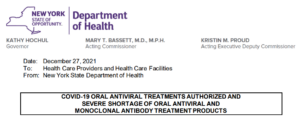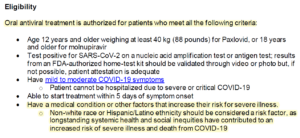NY State Announces Racially Discriminatory Standard For Rationing COVID Therapeutic Treatment

Citing a “significant surge” in COVID cases and “severe resource limitations”, the New York State Department of Health this week announced it would ration oral antiviral and monoclonal antibody treatments based on race:
Oral antiviral treatment is authorized for patients who meet all the following criteria (emphasis added):
- Age 12 years and older weighing at least 40 kg (88 pounds) for Paxlovid, or 18 years and older for molnupiravir
- Test positive for SARS-CoV-2 on a nucleic acid amplification test or antigen test; results from an FDA-authorized home-test kit should be validated through video or photo but, if not possible, patient attestation is adequate
- Have mild to moderate COVID-19 symptoms o Patient cannot be hospitalized due to severe or critical COVID-19
- Able to start treatment within 5 days of symptom onset
- Have a medical condition or other factors that increase their risk for severe illness.
Non-white race or Hispanic/Latino ethnicity should be considered a risk factor, as longstanding systemic health and social inequities have contributed to an increased risk of severe illness and death from COVID-19
Based on these guidelines, non-whites do not need to show they personally are at risk for severe illness, it is presumed from their racial and ethnic status. Whites need proof, a clearly discriminatory standard.
Such brazen discrimination against white Americans based on vague, sweeping claims of “systemic” “inequities” was rejected by several federal courts earlier this year when they considered the Biden Administration’s race-based pandemic relief programs. In those cases, the courts “rejected systemic racial discrimination as a compelling state interest to support race-based legislation.”
It seems inevitable that there will be constitutional challenges to the New York State Health Department policy prioritizing medical treatment based on race, just as there were to the race-based pandemic relief programs. When the government denies a benefit to citizens based on race, it must meet a very high standard to pass constitutional muster. The Biden Administration was unable to come up with the kind of concrete evidence necessary to do so. As the Sixth Circuit observed, “the bar is a high one,” and it is hard to see how New York State will be able to meet it.
————————–
Jane Coleman writes on law and policy and lives in New Jersey. Her legal treatise Secondary Trademark Infringement was published by Bloomberg BNA. You can follow Jane on Twitter @JaneBColeman and LinkedIn.
CLICK HERE FOR FULL VERSION OF THIS STORY

